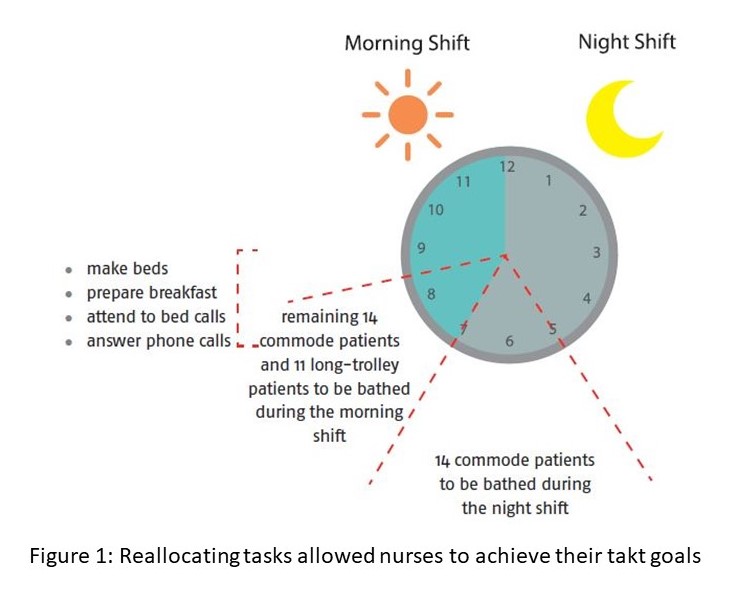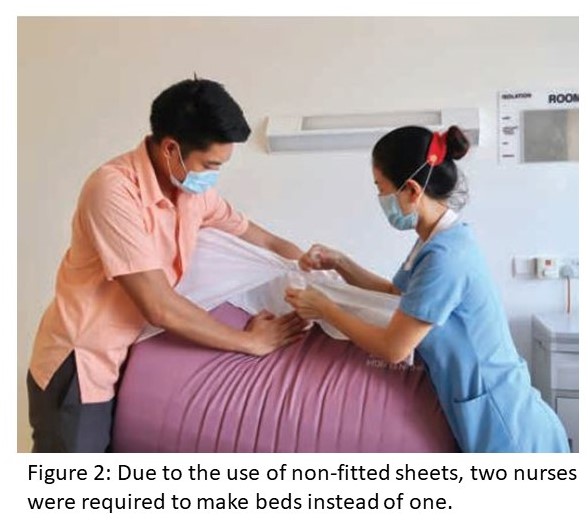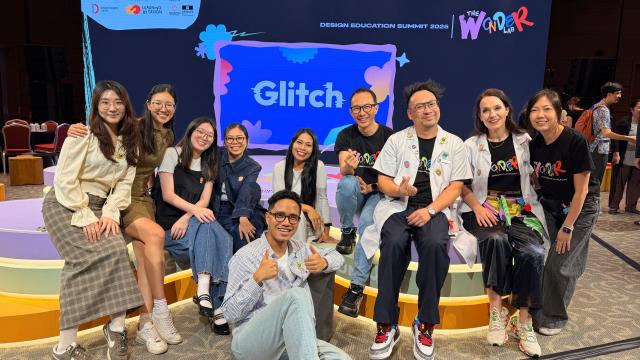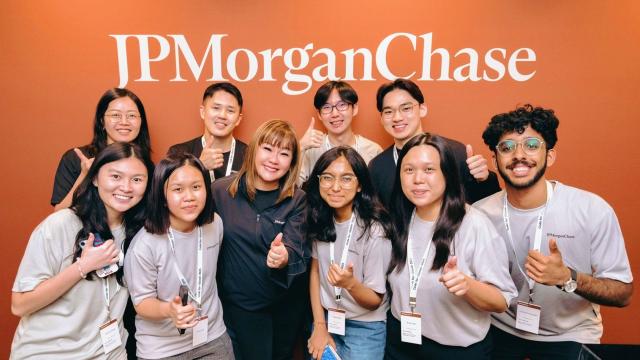
Faced with a limited capacity of 600 beds, Kwong Wai Shiu Hospital is keen to improve the efficiency and effectiveness of its processes in order to open up more beds for more patients and improve the patient experience. One of its targeted problems was to reduce the heavy workload for nurses in its wards.
Each morning between 7:00 a.m. and 9:00 a.m., nurses have to prepare breakfast, bathe the residents, as well as make their beds. Juggling these tasks within a short amount of time presented a huge challenge daily and generated stress.
A team of three, comprising a human resource representative and two staff nurses, who had taken part in the six-month Lean Skills Development Programme (LSDP) offered by SIT, in partnership with the Lean Global Network, thus got down to work immediately by collaborating with nurses on Lean Thinking approach.
 The team started by setting a goal to complete the bathing all residents of a particular ward by 8:30 a.m. instead of 9:20 a.m. each day. This targeted end time would help to free up more resources for other activities in the ward. In order to achieve this, the team worked out the takt time, which is the maximum acceptable time allowed in meeting the demands of a customer. It turned out that the 28 residents who needed to be showered on a commode chair (i.e. an indoor wheelchair) required more time than expected.
The team started by setting a goal to complete the bathing all residents of a particular ward by 8:30 a.m. instead of 9:20 a.m. each day. This targeted end time would help to free up more resources for other activities in the ward. In order to achieve this, the team worked out the takt time, which is the maximum acceptable time allowed in meeting the demands of a customer. It turned out that the 28 residents who needed to be showered on a commode chair (i.e. an indoor wheelchair) required more time than expected.
Instead of bathing residents only in the morning, the team decided to start bathing 14 of those residents during the night shift, so as to achieve the takt time allotted in the morning. Since rescheduling tasks, nurses were able to successfully achieve their goal of completing bathing all residents by 8.30 a.m. each morning.
“People are happier at work, and that’s something we value a lot,” said the project team, adding that staff did not feel as overwhelmed anymore with this process. The transformation also freed up one nurse in the morning, who could instead attend to other urgent tasks such as tending to bell calls or the phone.
Optimising Workflows
 Besides optimising their task schedule, the team also sought further ways to free up nurses for other ad-hoc or value-added tasks. One bottleneck that was identified in nurses’ daily routine was bed-making. Bed-making was resource-intensive as two nurses were required to make each bed due to the use of non-fitted sheets, which needed to be manually tied in order to stay in place.
Besides optimising their task schedule, the team also sought further ways to free up nurses for other ad-hoc or value-added tasks. One bottleneck that was identified in nurses’ daily routine was bed-making. Bed-making was resource-intensive as two nurses were required to make each bed due to the use of non-fitted sheets, which needed to be manually tied in order to stay in place.
To optimise the bed-making activity, the team showed the hospital’s management a video of how beds were made. Seeing the challenges on the ground, the hospital immediately agreed to introduce fitted sheets which do not require any tying or adjustments. This further spurred the team on to challenge themselves with a more ambitious goal – of completing all bathing tasks by 8:00 a.m. instead of 8:30 a.m.
Challenges and Reflections
The tools and principles from Lean Thinking have presented staff at Kwong Wai Shiu Hospital with new ways of approaching their daily work issues and how they could identify problems and effects before exploring solutions. Although the project team encountered challenges at the start, they were able to break down barriers by engaging in discussion with all parties involved. They also expressed that it was useful to learn different ways of solving problems scientifically by seeing and fully understanding problems “as opposed to complaining about it and trying to fix it without fully understanding it”.
Through their coaching sessions with trainers from SIT, staff could gain a deeper insight into what and where the “real” problems were, where and how to apply lean tools, and how to engage in the human-centred exploration of what it means to care for the hospital’s residents. Over time, this convinced even those individuals who were most opposed to change, to work together to eliminate or reduce the effects of the problems the organisation faced, without increasing staff count. They understood that Lean Thinking delivers greater value not only to staff, but also to the residents of Kwong Wai Shiu Hospital.
Today, Kwong Wai Shiu Hospital employs Lean Thinking as a process improvement tool to drive problem solving and continuous improvement deep into the management of the organisation. In fact, as it progresses with the training and coaching sessions with SIT coaches, Lean Thinking is slowly becoming the core element of the hospital’s culture, infused into the way staff members think about and perform their tasks, and how they collaborate and share a common vision with other stakeholders.
Having been appointed as the Community Training Institute (CTI) in Singapore, Kwong Wai Shiu Hospital is now better positioned with its role as a Lead Enterprise and to catalyse the Lean and Innovation mindset among the Community Care sector.
Case study adapted from 'The Learning Enterprise: Innovative Practices for Organisational Transformation', a book by NACE@SIT that documents the learning journey of four local companies with SIT to pioneer workplace learning and Lean transformation.
Read more about Kwong Wai Shiu Hospital's latest collaboration with NACE@SIT and SkillsFuture Singapore to upskill and reskill the Community Care workforce and strengthen leadership core.















![[FA] SIT One SITizen Alumni Initiative_Web banner_1244px x 688px.jpg](/sites/default/files/2024-12/%5BFA%5D%20%20SIT%20One%20SITizen%20Alumni%20Initiative_Web%20banner_1244px%20x%20688px.jpg)


